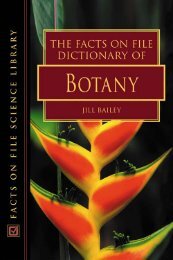You also want an ePaper? Increase the reach of your titles
YUMPU automatically turns print PDFs into web optimized ePapers that Google loves.
These vascular tissues occur nearer to the apex in<br />
slow growing or dormant roots than in actively<br />
elongaring roots. The firsr mature protOphloem<br />
elements appear at the circumference of the<br />
procambial cylindet and differentiate closer to the<br />
root apex than the first mature protOxylem (4.8).<br />
By contrast the prospective met'axylem becomes<br />
demarcated, by its prominent vacuolation growth<br />
(4.5), nearer the apex than the protophloem. Some<br />
distance basal ro the prorophloem, mature protoxylem<br />
elements develop between the prorophloem<br />
files. Maturation of the metaphloem and<br />
metaxylem proceeds centripetally (4.30) on the<br />
radii already demarcated by the protophloem and<br />
protoxylem (4.8), and the vascular system of the<br />
mature primary rOOt is formed (4.31). The outer<br />
layer of the procambium gives rise 10 the<br />
parenchymatous pcricyle (4.8,4.31).<br />
In dicotyledonous roots the tissue between the<br />
xylem and phloem often forms a cambium (4.31),<br />
which later spreads laterally over the protoxylem<br />
poles ro form a COntinuous meristem (1.25). The<br />
vascular cylinder is invested by the parenchymatous<br />
cortex (1.29, 4.30} which frequently<br />
contains conspicuous intercellular air spaces. The<br />
pericycle is bounded by the single layered<br />
endodermis (1.29, 4.31, 4.32) whose radial and<br />
transverse walls are impregnared with lignosuberin<br />
to form Casparian bands (4.33). These<br />
laterally continuous bands are impermeable, so<br />
that all water and solute movement across Ihis<br />
layer is confined to the symplast (4.33). In the<br />
roots of many species, particularly monocotyledons,<br />
the ligno-suberisation of the endodermis<br />
86<br />
later extends to all walls and additional cellulose<br />
thickening may be deposited (4.32). Such cells,<br />
however, still allow symplastic transport from rhe<br />
cortex ro the stele via their plasmodesmata.<br />
The endodermis is an important selective<br />
barrier but it allows the active transport into the<br />
vascular cylinder of certain beneficial ions<br />
(potassium, phosphare) absorbed from the soil.<br />
Calcium, however, apparently moves apoplastially<br />
and cannor corer the vascular cylinder through the<br />
endodermis, but instead passes into the vascular<br />
cylinder in the very immarure root where<br />
Casparian bands have not developed. The active<br />
transport of ions into the vascular cylinder<br />
accounts for the phenomenon of roOt pressute<br />
which sometimes plays an accessory role to<br />
transpiration in the movement of water to Ihe<br />
shoot.<br />
to some roots the ourer cortex diffetentiates as<br />
a one- ro several-layered exodermis (1.29) but the<br />
Casparian bands in the tadial walls are usually<br />
masked by deposition of subetised lamellae<br />
adjacent ro the protoplast (4.34). A short distance<br />
behind the apex a zone of absorptive root hairs<br />
develops from the epidetmis (4.27); but warer<br />
absorption also occurs over the test of the<br />
epidermal surface and in some species roar hairs<br />
are absent. In the aerial roots of some epiphytic<br />
orchids and aroids the multilayered epidermis<br />
develops into a dead velamen (4.34), whose walls<br />
are thickened by bands of cellulose. This is<br />
probably an adaption to absorb watet from the<br />
humid atmosphere of tropical forests.<br />
4.1 lu.s of the plwnule of Pht'lseo/us /lUfgaris (bean) seed.<br />
The hemispherical, densely-staining and small-eelled shoot<br />
apex (1) bears a pair of leaf primordia (2) at its margins<br />
which represent the first foliage leaves. A prominent strand<br />
of procambium (3) demarcates tbe longitudinal rows of<br />
vacuolated pith (4) from the cortex. (LM x 110.)<br />
1 Shoot apex<br />
2 Leaf primordium<br />
3 Procambium<br />
4 Pith





